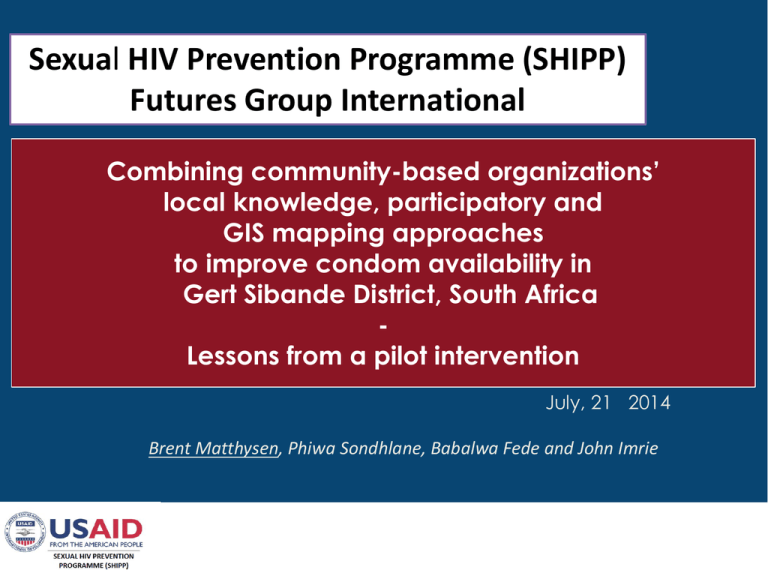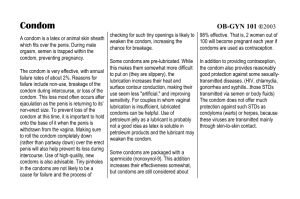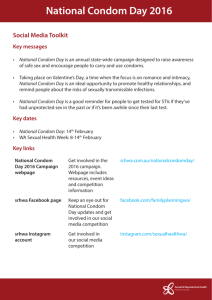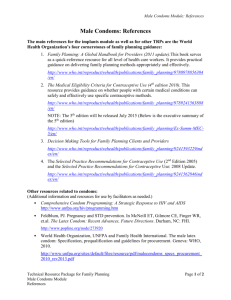Powerpoint - AIDS 2014 - Programme-at-a
advertisement

Sexual HIV Prevention Programme (SHIPP) Futures Group International Combining community-based organizations’ local knowledge, participatory and GIS mapping approaches to improve condom availability in Gert Sibande District, South Africa Lessons from a pilot intervention July, 21 2014 Brent Matthysen, Phiwa Sondhlane, Babalwa Fede and John Imrie Background • Condom use remains a core sexual HIV prevention intervention globally • However, ensuring the quality, quantity, distribution continuity & equity of freely-available condoms presents substantial challenges • Erratic & inequitable condom distribution, particularly in poor rural & hard-to-reach areas, results in poor uptake, inconsistent usage & an unwillingness to adopt condoms as a primary HIV prevention strategy Policy Context 1) South African National Department of Health is the main provider of freely-available condoms in the country 69.6 69.3 Amajuba DM 63.7 uMgungundlovu DM 55.3 49.1 Umzinyathi DM 43.0 42.7 42.6 39.1 Cape Winelands DM Central Karoo DM 30.8 27.9 27.0 25.2 25.2 24.7 24.6 24.3 23.2 23.1 22.5 19.8 19.3 19.1 18.3 18.2 18.1 17.6 17.5 16.9 16.8 16.1 15.9 15.9 15.5 15.1 15.1 14.9 14.6 14.4 13.8 12.8 12.7 12.6 12.2 11.8 9.9 9.0 8.9 7.1 6.3 5.6 5.5 Ehlanzeni DM Mopani DM Xhariep DM Zululand DM Sisonke DM O Tambo DM Gert Sibande T Mofutsanyane DM 19.1 Final target: 50 Male Condom Distribution Rates by District (2012-13) and Scale-up Targets 19 Uthungulu DM West Rand DM Nkangala DM RS Mompati DM Namakwa DM Umkhanyakude DM A Nzo DM Mid target: 36 2) Condom distribution has been variable & erratic Current average: 22 condoms Amathole DM Dr K Kaunda DM Cacadu DM eThekwini MM Johannesburg MM Ekurhuleni MM J T Gaetsewe DM 0.0 10.0 20.0 30.0 40.0 50.0 60.0 70.0 Source: Health Systems Trust, 2013. District Health Barometer 80.0 Policy Context (cont.) • South African NDoH is the main provider of freely-available condoms • Condom distribution across the country has been variable & erratic • 3) National plan aims to supply 1 billion condoms annually 50 male condoms per male aged ≥15 years Mpumalanga Province (South Africa) . . PRETORIA Johannesburg . Durban . Cape Town Pilot Site - Gert Sibande District Methodology Methodology – Step 1 Geospatial analysis of antenatal HIV rates prevalence, 2011 Methodology – Step 2 • Collaborative systems review of condom supply, management & distribution system – Poor: • condom supply • distribution coverage • monitoring (data recording) • data flow • reporting (NOT feeding the DHIS) • data analyses • information sharing Methodology – Step 3 Capacity-building workshops with SAG partners – District & Local Municipalities & CBOs 1. Know Your Epidemic & Response 2. Drawing of maps by hand: • mapping of infrastructure & services (107 CBOs & 242 persons) • plotting of hot spots & primary & secondary condom distribution points Methodology – Step 4 Plotting of sites using Global Positioning System hand-held devices Mapped & Plotted Potential Hot Spots & SCDPs Hot Spots Social, Health, Safety, Security & Civil Services Infrastructure Tuck Shops, Stores, Supermarkets & Markets Public Primary & Secondary Health Facilities Taverns, Bars & Shebeens (unlicensed) CBOs (nonSHIPP-funded) Hair Salons Police Stations Industry, Mines, Farms & Timber Sidings Libraries, Community & Information Centers Gas Stations Municipal Offices Truck Inns, Truck Stops & Taxi Ranks Social Development Services Offices Informal Settlements Other Government Department Offices Telecommunication Booths Post Offices Lodges, Guest Houses, Hotels & Inns Condom Warehouses / Depots Living Compounds & Hostels Car Wash Sites (informal) Brothels (all are illegal) Prisons Power Stations 1,800 sites mapped & plotted Methodology – Step 5 Creation of electronic maps using: − stored GPS coordinates − freeware Geographic Information Systems (GIS) software applications Collaborative amendment of condom distribution data collection tool used by the condom warehouse & other primary distribution points − auto-aggregation by week, month & quarter using MS Excel formulas Combining community-based organizations’ local knowledge and GIS mapping activities to improve condom availability Methodology – Step 6 Dissemination of e-maps to stakeholders for use in condom distribution scale-up planning & distribution activities Gert Sibande Condom Distribution Rates (Number of male condoms per male aged ≥15 years) 2013-14 60 53.8 50 40 40 34.7 28.3 30 20 10 0 19.4 25.1 25.8 27 32.2 28.2 27.6 25.7 27.1 25.6 Lessons Learned • Participatory approaches ensure CBOs acquire indepth understanding of mapping that is easily replicable without need of advanced additional technical support • Combining participatory approaches, GIS technology & CBOs’ indigenous knowledge can fast-track equitable condom distribution & coverage, & reach key populations such as rural communities Thank You www.futuresgroup_shipp.com The Sexual HIV Prevention Programme (SHIPP) is a United States Agency for International Development (USAID) – PEPFAR funded initiative in South Africa (SA) to galvanize and support combination HIV prevention activities. •Implementing partners include Futures Group, the Centre for AIDS Development, Research, and Evaluation, EngenderHealth, and Futures Institute.





